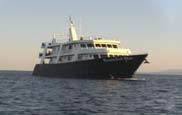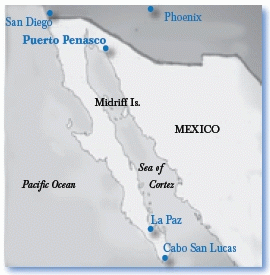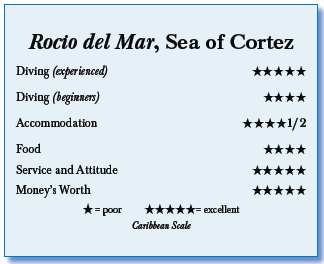Rocio del Mar, Sea of Cortez, MexicoContents of this Issue: Rocio del Mar, Sea of Cortez, Mexico Recalls of Mares Computers and Tusa Regulators Do the Drugs You Take Increase Bends Risk? Four Factors That Reduce Your Risk of DCS New Dangers of Rebreather Diving Where’s Your Customer Service, Scubapro? Asia-Pacific Divers Feeling More Jellyfish Stings New Diver-Tracking Rules in the Red Sea, But Will Divers Abide? Abalone Diver Dies “Doing Something He Loved” Editorial Office: Ben Davison Publisher and Editor Undercurrent 3020 Bridgeway, Suite 102 Sausalito, CA 94965 good liveaboard and fish life, with well-trained crew -- and sea lions from the March, 2010 issue of Undercurrent
Dear Fellow Diver: I’m in the middle of the Sea of Cortez, surrounded by scores of darting sea lions. Their underwater barks seem as loud as if I heard them on land. So I came with a surprise, a double-horn Dive Alert that I blew underwater. And guess what? I stopped them in their tracks. Every sea lion stopped barking, spun around and looked at me. If sea lions can look amazed, these did. I motioned to one curious guy by waving my hand toward me. “Come on over.” He moved a little closer every time I beckoned so I kept it up. When he got right up next to me, I spun my finger and he twirled away as if we had rehearsed it. I turned around and my fellow divers were clapping. A trip to the Sea of Cortez has its marvels, and the first of them is that a trip on this spanking new liveaboard, the 110-foot Rocio del Mar, begins by deplaning in Phoenix, Arizona. Following is a four-hour van ride to Puerto Penasco, but no matter where you go, there’s always a van ride somewhere. By skipping a change of planes, I figured I’d come out ahead, and I did. I was so pleased after my July trip that I went again in October, arriving with nine others at 4 p.m. for a 6 p.m. sailing.
The Rocio del Mar, with room for 22 passengers, was
built for diving. Owned by captain Lolo Sandoval and his
wife Dora, a dive
instructor, the craft
took nearly three
years to construct.
The builders -- those
who did the electrical,
welding, engine
installation, woodworking
and fiberglass
-- all became the
crew! Rest assured,
they can fix any problem
because they built
the boat. And now the entire crew is working to become divemasters.
Jorge and Julio pilot the Zodiacs and stay on
board during dives. After our first dinner aboard, each of us gave a brief diving bio. There were no newbies on board, usually the case with liveaboard diving. A hurricane had been crossing Baja, so there was a lot of chatter about whether it would affect our diving. After a good night’s sleep, I awoke at 6 a.m. and took a cup of coffee to the top deck to watch the sun rise and illuminate the stark islands. The dying hurricane had passed well to the south and while the week’s weather began windy, it cleared and I never missed a dive. After a light breakfast, the crew lifted the three Zodiacs -- two 19 feet long and a smaller one -- off the stern racks. You pick the Zodiac you want depending upon its dive site destination. I geared up and stowed my towel in a drawer under the seat. The main compressor was down but the small alternate took only a few extra minutes to handle the load and was fixed by the third dive, after Lolo used his satellite phone to call the company for tips. The crew helped everyone gear up (tanks are 80 cu. ft. and filled at each diver’s station), and I scuffled down four steps to the large dive platform. I was one of eight, four on each side. Divemaster Jorge coordinated our rolling backwards. The first dive was to 60 feet, no current, with visibility to 40 feet. I came across little piles of shells, which included cowries and murexes, and with more investigation, I found a large octopus, then another; both let me stroke their mantles. It was the typical Sea of Cortez fish life, from endless puffers to grunts and groupers. Visibility ran between 40 and 100 feet on all dives. On the surface, Jorge took all my gear so I could easily use the one-step ladder to get back on the Zodiac. The next dive was deeper, and I drifted with the slight current along a wall.
The water temperature began at 83 degrees, but as I descended through thermoclines
to 100 feet, it plummeted to 63 degrees. Dive times are set at 7 and 10:30 a.m., 1 and 4 p.m., plus a sunset or night dive. If the visibility or the wind was bad, Lolo moved the Rocio to a better spot and the Zodiacs followed. On one dive, the current meandered until I got between a couple of large rocks, then it increased to about two knots. Some divers surfaced to get out of it but I decided to go for a wild ride, heading up when I got down to 700 psi. Within seconds after sounding my Dive Alert, a Zodiac was alongside. On the second evening, anchored in a half-moon bay, the water was calm, the night spectacular. Underwater, the nightlife was happening. I saw more than 15 octopuses but few crab or lobster. Among all the active and diverse fish, standouts were a porcupine puffer looking like a perfect football, triggerfish and incredible parrotfish. Then some fun. On some dives, I hid under my BC a shark on a stick that opens its mouth when I pull a trigger at the bottom. When an unsuspecting soul is taking a photo, I slip Lucy into the picture. No one has tried to drown me yet. From then on, Lucy became a diver and a center of attention for some photographers. So I signed her in and out of the dives. Coffee, fruit, toast and bagels are ready at 6 a.m. Then first dive at 7 a.m., after which a full breakfast is served, cooked to order. The lunch is not heavy - - club sandwiches or tacos and an incredible soup daily. Every meal had five different fruits and juices. A typical dinner was pork tenderloin with vegetables, and Chef Pancho swirled gravy around the food like the decorations at the Coyote Cafe. Beer or wine is $2. If you want hard stuff, you have to bring it. The galley is on the bottom deck and comfortably seats 24 people. Up the stairs to the next deck, you’ll find eight cabins. Through a set of doors and you’re in the dive area. Up another flight of stairs is the audio/video room with a flat-screen TV, CD and DVD players, and leather couches to watch movies or review the day’s pictures. On this level is the wheelhouse and two more cabins, each with double beds and a single bunk on top to accommodate three people. All have a private bath with toilet, sink and shower, and each room has a large picture window to see the breathtaking scenery as the boat moves along. Diving around the Midriff Islands is cold in places because the water is pushed from the depths by extreme tides that can go 22 feet up and down twice a day. This sometimes creates an intense current as the water is pushed up from the bottom and shifts from tide change to tide change. There are times when it changes during a dive, so a diver and the chase boats need to be ready to adjust the dive. I wanted to see what the Sea of Cortez had that I wasn’t seeing by myself, so I asked divemaster Guillermo to point things out. The critters that were hiding in plain sight amazed me, especially seahorses, flatworms, and nudibranch in all the hues of the rainbow. A hairy lobster resided in a hole the size of a silver dollar, which Ned DeLoach (he’s the business partner of Fish ID guidebook author Paul Humann) tricked to the top of the hole with little tufts of seaweed and a lot of patience so he could shoot it. On every dive is a divemaster who watches without interference. At Bahia de Los Angeles, Dora and I took the Zodiac into a tiny fishing village to see if the fishermen had seen whale sharks. Bits of nets and flotsam held their colorful driftwood shacks together, and rope anchored them in case of wind. They had seen none for weeks, they said. We didn’t see any either, but I learned that several trips later, divers swam with seven whale sharks. (Dora put together a couple of boxes of supplies and blankets to be sent back to the fishermen. I’m sure that will be a ritual every trip because Bahia de Los Angeles is one of the stops now.) Thursday night was the outdoor BBQ on the top deck, which runs the length of the boat, interrupted by only the mast tower. (From here, we watched 20 sperm whales feed 100 feet away, a manta leap completely from the water, and minke and pilot whales and dolphins pirouetting and riding the bow wake.) Pancho set up picnic tables and grilled the dinner while we divers relaxed with drinks. During this night under the stars, the lights from the boat illuminated the water, attracting small fish, which in turn attracted hundreds of squid that broke the surface as they fed in the moonlight and starlight. Of course, the trip ended too soon. We packed up Friday night and boarded the van at 11 a.m. Saturday, getting us to the Phoenix airport around 3 p.m. Sharing close quarters for a week with your fellow divers always leads to friendships and bonding, extending good memories for a long time after your wetsuit dries. This trip was no exception. Even the van ride back was fun. -- A.W.
|

I want to get all the stories! Tell me how I can become an Undercurrent Online Member and get online access to all the articles of Undercurrent as well as thousands of first hand reports on dive operations world-wide
| Home | Online Members Area | My Account |
Login
|
Join
|
| Travel Index |
Dive Resort & Liveaboard Reviews
|
Featured Reports
|
Recent
Issues
|
Back Issues
|
|
Dive Gear
Index
|
Health/Safety Index
|
Environment & Misc.
Index
|
Seasonal Planner
|
Blogs
|
Free Articles
|
Book Picks
|
News
|
|
Special Offers
|
RSS
|
FAQ
|
About Us
|
Contact Us
|
Links
|
3020 Bridgeway, Ste 102, Sausalito, Ca 94965
All rights reserved.


 Aurelio, the master carpenter,
manages the dive platform. Dora joins
nearly all the dives and Lolo is on many.
Lea, another divemaster, lives in Rocky Point
and owned a dive operation in the area. José
Luis Robles from Puerto Vallarta was hired
for the trip; he’s a college professor and
teaches diving.
Aurelio, the master carpenter,
manages the dive platform. Dora joins
nearly all the dives and Lolo is on many.
Lea, another divemaster, lives in Rocky Point
and owned a dive operation in the area. José
Luis Robles from Puerto Vallarta was hired
for the trip; he’s a college professor and
teaches diving. Here, an incredible forest of yellow-blooming
black coral covered much the bottom,
serving as good camouflage for
several eels and a substantial grouper.
Nudibranchs and flat worms were everywhere
-- it’s like an Easter egg hunt
to look for them. Lots of scorpionfish
were nestled about while butterflyfish
and angelfish hung around long enough
for me to shoot them.
Here, an incredible forest of yellow-blooming
black coral covered much the bottom,
serving as good camouflage for
several eels and a substantial grouper.
Nudibranchs and flat worms were everywhere
-- it’s like an Easter egg hunt
to look for them. Lots of scorpionfish
were nestled about while butterflyfish
and angelfish hung around long enough
for me to shoot them.  Diver’s Compass: The price of a Saturday-to-Saturday trip is $1,950,
double occupancy, and there is a 10 percent Mexican tax for each diver
. . . The round trip in the comfortable, air-conditioned van was $100 .
. . Nitrox not offered . . . Puerto Penasco, “Rocky Point” in English,
sits east of Mexico’s northernmost point and is an inexpensive, beautiful,
little town, like an early Cozumel; a small commercial airport
may be operating there later this year . . . You need a passport to
get into Mexico, even by land. . . Website for Rocio del Mar (named for
Dora’s daughter, Rocio):
Diver’s Compass: The price of a Saturday-to-Saturday trip is $1,950,
double occupancy, and there is a 10 percent Mexican tax for each diver
. . . The round trip in the comfortable, air-conditioned van was $100 .
. . Nitrox not offered . . . Puerto Penasco, “Rocky Point” in English,
sits east of Mexico’s northernmost point and is an inexpensive, beautiful,
little town, like an early Cozumel; a small commercial airport
may be operating there later this year . . . You need a passport to
get into Mexico, even by land. . . Website for Rocio del Mar (named for
Dora’s daughter, Rocio): 